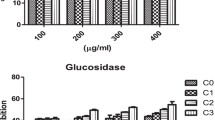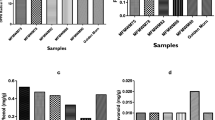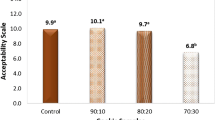Abstract
This study examined the ability of ackee arils flour to serve as substitute for margarine in cookies production and the possibility of employing wheat-ackee arils cookies as functional food. Four samples of cookies were formulated, which include; the control, cookies with 30 g margarine (NAFC), cookies with 20 g margarine + 10 g ackee arils flour (AF1), cookies made with 10 g of margarine + 20 g of ackee arils flour (AF2), and cookies prepared from 30 g ackee arils flour (AF3). Wheat-ackee arils cookies were evaluated for physico-chemical properties, α-amylase and α-glucosidase inhibitory activities along with glycemic load and glycemic index. The energy values of the cookies ranged from 428.74 kcal/100 g in AF3 to 450.22 kcal/100 g in AF1, the energy values of samples were significantly (p < 0.05) lower when compared with control NAFC. The result of the cookies diameter revealed that sample AF3 have the highest mean diameter value (5.13 cm) while NAFC the control sample had the least mean value of (3.26 cm). Ackee arils cookies extract influenced the in-vitro inhibitory properties of α-amylase and α-glucosidase linked to type 2 diabetic mellitus. A combination of 20 g ackee aril and 10 g margarine showed the highest inhibitory effect of 51.35%-90.54% from 50 µg/mL- 200 µg/mL concentration for α-amylase and α-glucosidase. It may be concluded that ackee arils flour can serve as a replacement for margarine in cookies production and wheat-ackee aril cookies may be considered as a functional food.





Similar content being viewed by others
References
Ekué, M. R. M., Sinsin, B., Eyog-Matig, O. and Finkeldey, R. Uses, traditional management, perception of variation and preferences in ackee (Blighia sapida K.D. Koenig) fruit traits in Benin: implications for domestication and conservation. Journal of Ethnobiology and Ethnomedicine, 6(12): 1–14 (2010)
S.O. Agunbiade, O.M. Ighodaro, I.A. Osinbola, Effects of maturation and stem cooking on akee apple aril nutritional and phytochemical properties. Adv. Biores. 3(1), 03–06 (2012)
Ouattara, H., Niamké B., Dally T. and Kati-Coulibaly S. Nutritional composition studies of sun dried blighia sapida (k.koenig) aril 1989, nutritional composition studies of sun dried blighia sapida (k. koenig) aril from Côte d’Ivoire. Journal of Applied Biosciences 32: 1989–1994 (2010)
Singh, P., Gardner, M., Poddar, S., Choo-Kang, E., Coard, K., and Rickards, E. Toxic effects of ackee oil (Blighia sapida L.) following subacute administration to rats. West Indian Medical Journal. 41(1): 23–6 (1992)
Rashford, J. Ackee poisoning and the evolutionary biology of Jamaica's ackee motif. Proceedings of the thirty second annual meeting of the Caribbean food crops society, Zamorana, Honduras, Central America, 7–13 July 1996. St Croix, US Virgin Islands: CFCS. 185–192 (1997)
J. Rashford, A critique of Scott’s theory of the relationship between ackee seasonality and ackee poisoning. Trop Fruits Newsl IICA Trinidad, Newtown 32, 7–10 (1999)
K.D. Golden, O.J. Williams, Y. Bailey-Shaw, High-performance liquid chromatographic analysis of amino acids in ackee fruit with emphasis on the toxic amino acid hypoglycin A. J. Chromatogr. Sci. 40, 441–446 (2002)
S. Storozhenko, E. Belles-Boix, E. Babiychuck, D. Hérouart, M.W. Davey, L. Slooten, M.V. Montagu, D. Inźe, S. Kushnir, γ-Gutamyl transpeptidase in transgenic tobacco plant. Cellular location, processing and biochemical properties. Plant Physiol. 128, 1109–1119 (2002)
Lancashire, R. J. Jamaican Ackee http.//www.chem.uwimona.edu.jm/lectures/ackee. (2006) Html. retrieved Feb (2019)
Golden, K. D. Hypoglycin: a toxic amino acid of the ackee plant. Caribbean Poison Information Network (CARPIN) first scientific conference June 3–4, (2006)
O. Atolani, G.A. Olatunji, O.A. Fabiyi, Blighia sapida: The plant and its hypoglycins an overview. J. Sci. Res. XXXIX(2), 15–25 (2009)
A.A. Gbolade, Inventory of antidiabetic plants in selected districts of Lagos state, Nigeria. J. Ethnopharmacol. 121, 135–139 (2009)
A.N. Saidu, A. Mann, C.D. Onuegbu, Phytochemical screening and hypoglycemic effect of aqueous blighia sapida root bark extract on normoglycemic albino rats. Br. J. Pharma. Res. 2(2), 89–97 (2012)
J. Booyens, C.C. Louwrens, I.E. Katzeff, The role of unnatural dietary trans and cis unsaturated fatty acids in the epidemiology of coronary artery disease. Med. Hypotheses 25, 175–182 (1988)
American Heart Association (AHA), Standards of medical care in heart. Heart Care 36(1), S11–S66 (2000)
R. Singh, G. Singh, G.S. Chauhan, Effect of incorporation of defatted soy flour on the quality of biscuits. J. Food Sci. Technol. 33, 355–7 (1996)
A.P. Alobo, Effect of sesame seed flour on millet biscuit characteristics. Plant Foods Hum. Nutr. 56, 195–202 (2001)
J.A. Ayo, V.A. Ayo, I. Nkama, R. Adewori, Physicochemical, invitro digestibility and organoleptic evaluation of acha-wheat biscuit supplemented with soybean flour. Niger. Food J. 5, 32–8 (2007)
A.I. Olagunju, B.O.T. Ifesan, Nutritional composition and acceptability of cookies made from wheat flour and germinated sesame (Sesamum indicum) flour blends. Br. J. Appl. Sci. Technol. 3(4), 702–713 (2013)
B.O.T. Ifesan, F. Ebosele, Chemical properties of watermelon seed and the utilization of dehulled seed in cookies production. Carpathian J. Food Sci. Technol. 9(1), 126–135 (2016)
D. Saika, S.C. Deka, Cereals: from staple food to nutraceuticals. Int. Food Res. J. 18, 21–30 (2011)
F. Ahmad, F.A. Ahmad, A.A. Azad, S. Alam, A.S. Ashraf, Nutraceuticals is the need of hour. World J. Pharm. Pharma. Sci. 2, 2516–2525 (2013)
S. Ruchi, A. Kaur, S. Thakur, K. Bhardwaj, S. Bose, Role of nutraceutical in health care: a review. Int. J. Green Pharma. 11(3), s385–s394 (2017)
O.O. Awolu, P.M. Oluwaferanmi, O.I. Fafowora, G.F. Oseyemi, Optimization of the extrusion process for the production of ready-to-eat snack from rice, cassava and kersting’s groundnut composite flour. LWT Food Sci. Technol 64, 18–24 (2015)
N. Jong-Anurakkun, M.R. Bhandari, J. Kawabata, Alpha-glucosidase inhibitors from Devil tree (Alstonia scholaris). Food Chem. 103, 1319–1323 (2007)
T. Ieyama, M.D. Gunawan-Puteri, J. Kawabata, α-Glucosidase inhibitors from the bulb of Eleutherine Americana. Food Chem. 128(2), 308–311 (2011)
Y.M. Kim, M.H. Wang, H.I. Rhee, A novel alpha-glucosidase inhibitor from pine bark. Carbohyd. Res. 339(3), 715–727 (2004)
M. Brown, R.P. Bates, C. McGowan, J.A. Cornell, Influence of fruit maturity on the hypoglycin A level in ackee (Blighia sapida). J. Food Saf. 12(2), 167–177 (1992)
AOAC. Association of Official Analytical Chemist. official methods of analysis of the analytical chemist international, 18th ed. Gathersburg, MD USA (2012)
P. Tiwari, B. Kumar, M. Kaur, Kaur G, Kaur H: Phytochemical screening and extraction: a Review. Internationale Pharmaceutica Sciencia 1, 98–106 (2011)
S.S. Gowri, K. Vasantha, Phytochemical screening and antibacterial activity of syzygiumcumini (L) (Myrtaceae) Leaves Extracts. Int. J. Pharm Tech Res. 2(2), 1569–1573 (2010)
Sofowora, A. Medicinal plants and traditional medicines in Africa, spectrum Book Ltd, Ibadan, Nigeria. 2- 85 (1993)
J.B. Harborne, Text book of phytochemical methods (Chapman and Hall, London, 1974), pp. 49–188
V.L. Singleton, R. Orthofer, R.M. Lamuela-Raventos, Analysis of total phenols and other oxidation substrates and antioxidants by means of Folin-Cioalteau Reagents. Meyhods Enzymol. 299, 152–178 (1999)
B.O. Obadoni, P.O. Ochuko, Phytochemical studies and comparative efficacy of the crude extracts of some homeostatic plants in Edo and Delta states of Nigeria. Glob J Pure Appl Sci 8, 203–208 (2001)
G.N. Medoua, I.L. Mbome, T. Agbor-Egbe, C.M.F. Mbofung, Influence of fermentation on some quality characteristics of trifoliate yam (Dioscorea dumetorum) hardened tubers. Food Chem. 107(3), 1180–1186 (2007)
S. Bushra, A. Farooq, A. Muhammad, Effect of extraction solvent/technique on the antioxidant activity of selected medicinal plant extracts. Molecules 14, 2167–2180 (2009)
L.J. Shai, P. Masoko, M.P. Mokgotho, Yeast alpha glucosidase inhibitory and antioxidant activities of six medicinal plants collected in Phalaborwa, South Africa. South Afr. J. Bot 76(3), 465–470 (2010)
A. Ademiluyi, G. Oboh, Soybean phenolic-rich extracts inhibit key-enzymes linked to type 2 diabetes (α-amylase and α -glucosidase) and hypertension (angiotensin 1 converting enzyme) in vitro. Exp. Toxicol. Pathol. 65(3), 305–309 (2013)
T.M.S. Wolever, D.J.A. Jenkins, A.L. Jenkins, R.G. Josse, The glycaemic index: methodology and clinical implications. Am. J. Clin. Nutr. 54, 846–854 (1991)
J. Salmeron, J.E. Manson, M.J. Stampfer, G.A. Colditz, A.L. Wing, W.C. Willett, Dietary fiber, glycaemic load, and risk of non-insulin-dependent diabetes mellitus in women. J. Am. Med. Assoc. 277, 472–477 (1997)
Ihekoronye, A. I and Ngoddy, P. O. Integrated food science and technology for the tropics. (2nd ed.) macmillan publishers Ltd. London (1985)
IBM Corp. IBM SPSS Statistics for windows, version 23.0. Armonk, NY: IBM Corp (2013)
V.M. Dossou, J.K. Agbenorhevi, S. Combey, S. Afi-Koryoe, Ackee (Blighia sapida) fruit aril: nutritional, phytochemicals and antioxidant properties. Int. J. Nutr. Food Sci. 3(6), 534–537 (2014)
B.A. Origbemisoye, B.O.T. Ifesan, Chemical composition of ‘kiaat’ (Pteropcarpus angolensis) bark and the effect of herb pastes on the quality changes in marinated cat fish during chilled storage. Food Biol. 8, 07–12 (2019)
FAO, Protein quality evaluation, Report of the joint FAO/WHO Expert consultation Bethesda, MD., USA (2007)
M.O. Aremu, O. Olaofe, E.T.A. Akintayo, Comparative study on the chemical and amino acid composition of some Nigerian underutilized legume flours. Pak. J. Nutr. 5, 34–38 (2012)
M.B.F. Jemziya, T. Mahendran, Physical quality characters of cookies produced from composite blends of wheat and sweet potato flour. Ruhuna J. Sci. 8, 12–23 (2017)
Gurr, M. I. and Asp, N. G. Dietary fiber. ILSI Europe concise monograph series. Brussels, Belgium: ILSI Press. 15–19 (1994)
A. Aleixandre, M. Miguel, Dietary fibre in the prevention and treatment of metabolic syndrome: a review. Crit. Rev. Food Sci. Nutr. 48(10), 905–912 (2008)
G.I. Okafor, F.C. Ugwu, Production and evaluation of cold extruded and baked ready-to eat snacks from blends of breadfruit (Treculia africana), cashew nut (Anacardium occidentale) and coconut (Cocos nucifera). Food Sci. Qual. Manag. 23, 65–77 (2014)
C. Nishida, R. Uauy, WHO scientific update on health consequences of transfatty acids: introduction. Eur. J. Clin. Nutr. 63(2), 1–4 (2009)
FAO/Nurition, Fats and fatty acids in human nutrition: report of an expert consultation. FAO Food and Nutrition Paper 91. Rome: Food and Agriculture Organization of the United Nations (2010)
L. Hooper, A. Abdelhamid, H.J. Moore, W. Douthwaite, C.M. Skeaff, C. Summerbell, DEffect of reducing total fat intake on body weight: systematic review and meta-analysis of randomised controlled trials and cohort studies. BMJ 345, e7666 (2012)
M. Saxena, J. Saxena, R. Nema, D. Singh, A. Gupta, Phytochemistry of medicinal plants. Center for microbiology and bio-technology research and training. J. Pharmacog. Phytochem. 8192(1), 168–182 (2013)
M.C. Ojinnaka, P.I. Okolie, B.A. Idorenyin, Quality assessment of biscuits produced from wheat-aerial yam-plantain flour blends. Int. J. Food Sci. Nutr. 4(2), 97–101 (2019)
G. Oboh, B.O. Opeyemi, D.O. Mariam, A.A. Stephen, Influence of gallic acid on a -amylase and a-glucosidase inhibitory properties of acarbose. J. Food Drug Anal. 24, 627–634 (2016)
G. Oboh, A.A. Olabiyi, A.J. Akinyemi, A.O. Ademiluyi, Inhibition of key enzymes linked to type 2 diabetes and sodium nitroprusside-induced lipid peroxidation inrat pancreas by water-extractable phytochemicals from unripe pawpaw fruit (Carica papaya). J Basic Clin Physiol Pharmacol 25, 21–34 (2014)
Mendosa, D. The glycaemic index. Helping fight diabetes since 1995. https://www.mendosa.com/gilists.htm (2009)
C.A. Ikpeme, N.C. Osuchukwu, L. Oshieel, Functional and sensory properties of wheat (Aestium triticium) and taro flour (Colocasia esculenta) composite bread. Afr. J. Food Sci. 4(5), 248–253 (2010)
Author information
Authors and Affiliations
Corresponding author
Additional information
Publisher's Note
Springer Nature remains neutral with regard to jurisdictional claims in published maps and institutional affiliations.
Rights and permissions
About this article
Cite this article
Origbemisoye, B.A., Ifesan, B.O. Nutritional, phytochemical, glycaemic index, antihyperglycaemic properties and quality attribute of Wheat-ackee arils cookies for diabetic patients. Food Measure 15, 144–154 (2021). https://doi.org/10.1007/s11694-020-00623-w
Received:
Accepted:
Published:
Issue Date:
DOI: https://doi.org/10.1007/s11694-020-00623-w




